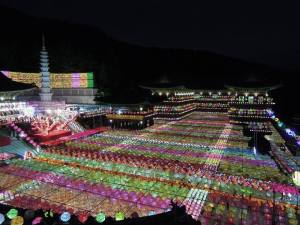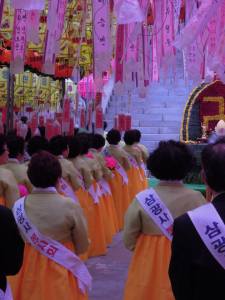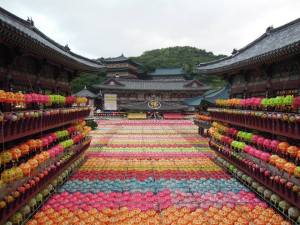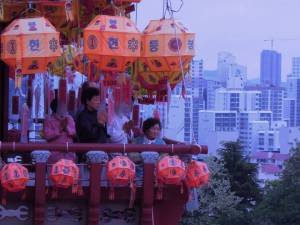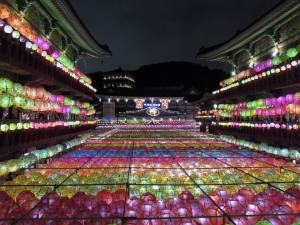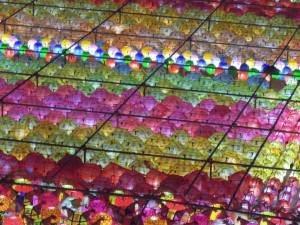I had met Miju after school and we headed from Seomyeon to the streets of Choeup-dong in a taxi. We arrived at the final junction and hopped out of the cab. At the base of a simple T-junction seven Korean police officers, two “best-driver” taxi drivers and three retired military men (but dressed ready, John Terry style) were over-effectively directing the two-way traffic (the side-road was closed) with their annoying whistles and fluorescent batons. At the top of the side-road lay Samgwangsa one of the most important Buddhist Temples and possibly one of the largest in the region.
Samgwangsa is a relatively modern temple. Built in 1969 and in honour of the Great Patriarch SangWol WonGak, who revived the Chontae order, it serves a large Buddhist community. Whilst other temples are famed for their history, design or religious importance, Samgwangsa is seen as an example of the future of Buddhism, embracing the modernisation, intenationalisation and popularisation of Buddhism. Anyway, enough history if you want to know more about the temple click this link!
We entered the temple grounds shortly before the sunsets and walked straight beneath the ceiling of lanterns that had been arranged in the courtyard. People were bustling around and the commencement of the opening ceremony was on the verge of starting. Participants in the ceremony were dressed in traditional Korean Hanbok and guided/protected by wily old men in black suits with the mandatory flourescent baton. From beneath the ceiling of coloured lanterns we tried to gain access to the steps that led to the main shrine and pagoda, but were ushered back by said aged security. As the proceedings began and the faithful in attendance directed their prayers towards the speaker in the pagoda we walked towards one of the main halls that flanked the courtyard. Here we were seeking access to the balconies that overlooked the lanterns below. Inside the hallways we walked around looking for access to some stairs as busy women bustled around with platters of food. The rooms that lined the hallways were filled with more women dining on the Korean traditional food that overwhelmed the corridors with the pungent smells of kimchi, jjigaes and steamed pork. Finding the stairwell we checked out the views from the second and third floors. The ends of the balconies were crowded with worshippers gaining access to a view of the speakers in front of the main shrine. The rest of the space was littered with amateur photographers and their tripods, jostling for that perfect shot when the sun went down and the lights came on.
Across the courtyard elderly women lined the steps of a huge building. Chilled from the cold air and pesky wind we sought shelter inside and found an entrance that wasn’t blocked off by people or inaccessible. As we entered this huge building we came into a huge hall, allegedly able to accommodate 10,000 people. On the ground floor hundreds of people sat on cushions before a stage filled with images of Buddha. The sermon from outside was being piped through a sound-system and streamed onto TV’s. When something profound was said a ripple of applause would fill the hall. As my eyes inspected the surroundings something in my mind was becoming increasingly apparent and clear… 22.8% of people in South Korea are Buddhist. After my visit to Samgwangsa I believe 98% of that 22.8% are 할 머니 (grandmothers). Never have I seen such a greater concentration of elderly aged women in one place. After a period of personal wonderment we took to the stairs again. Upstairs the hall had stadium style seating- perfect for 할 머니 watching. People crowded around the windows, a mixture of Buddhist worshippers and amateur photographers jostled for position. The lights outside went off and to an approving round of applause and a few gasps of amazement the lanterns were switched on.
Back outside we queued at the steps and waited for the men in black to allow us to see the main shrine. As the ropes were removed the floodgates were opened. We climbed the steps not trying to stumble-over people and a frisky grandmother used my bum as support as she climbed behind me. People clambered into the shrine, depositing their shoes in plastic bags at the entrance; a look through the doorway was enough for me, my hands too cold to be bothered with shoelaces. We took a few pictures of the nine-story, eight-sided “Tahp” and of the two dragons that formed the artistic centrepiece of the lantern display before deciding that we had seen enough. We made our way down the steep streets and went off in search of a nice warm bowl of Japanese noodles…

